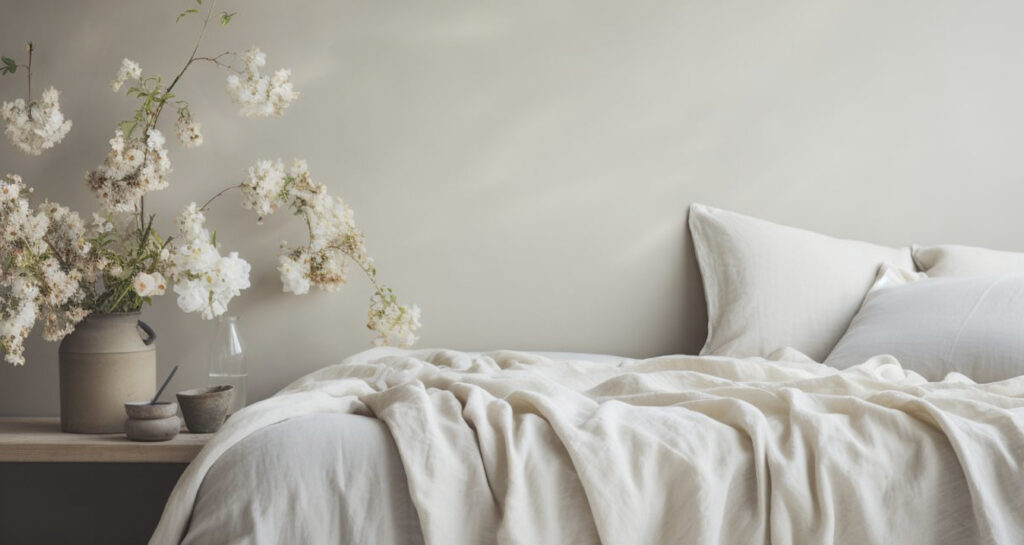Good sleep is essential for our overall health and well-being, yet many of us struggle to get the rest we need. While lifestyle factors like diet and stress management play a significant role, the design and ambience of your bedroom are also critical components of sleep hygiene. By carefully considering elements like colour, layout, and decor, you can create a sanctuary that promotes relaxation and better sleep.
In this post, we’ll explore how you can use design and NEO’s paint ranges to turn your bedroom into a restful retreat.
Choose Calming Colours
Colour has a profound effect on our emotions and can significantly influence our ability to unwind. When it comes to the bedroom, it’s important to choose colours that promote calmness and tranquility.
- Soft Neutrals: Shades like soft beige, warm taupe, and creamy whites create a serene backdrop that fosters relaxation. These colours are also versatile and can complement numerous design styles.
- Muted Blues: Blue is a naturally calming colour, often associated with feelings of peace and serenity. Opt for muted tones like powder blue, slate, or soft turquoise to enhance a restful atmosphere.
- Gentle Greens: Green symbolises nature and renewal, making it an excellent choice for a bedroom. Soft, muted greens like sage or moss create a soothing environment conducive to sleep.
- Lavender and Pastel Pinks: These soft hues can evoke a sense of calm and relaxation, helping to ease stress and tension.
- Avoid overly bright or stimulating colours like vivid reds, oranges, or electric blues, as they can increase alertness and make it harder to wind down.
Focus on Minimalist Design
Cluttered spaces can be overstimulating and lead to feelings of anxiety. A minimalist approach to bedroom design can help create a peaceful environment.
- Clear the Clutter: Keep surfaces like nightstands, dressers, and floors free of unnecessary items. Consider incorporating storage solutions like baskets, drawers, and shelving to keep your space tidy.
- Simplify Your Decor: Choose a few key pieces of decor that you love and that contribute to the overall tranquility of the space. A beautiful piece of art, a simple vase with fresh flowers, or a well-chosen throw can add warmth without overwhelming the room.
Invest in Comfortable Bedding
Your bed is the focal point of your bedroom, and its comfort is paramount to good sleep. Invest in high-quality bedding that feels luxurious and inviting.
- Choose Natural Fabrics: Opt for sheets, pillowcases, and blankets made from natural fibres like cotton, linen, or bamboo. These materials are breathable and help regulate body temperature, ensuring a comfortable night’s sleep.
Optimise Lighting
Lighting plays a crucial role in regulating your sleep-wake cycle. Proper lighting can signal to your body that it’s time to wind down, while harsh or excessive lighting can disrupt your sleep.
- Use Dimmable Lights: Install dimmable lights or use lamps with soft, warm-toned bulbs to create a relaxing ambiance in the evening. Avoid bright overhead lights in the hours leading up to bedtime.
- Incorporate Blackout Curtains: If outside light is an issue, consider installing blackout curtains or shades to block out any light that might disturb your sleep.
- Consider Soft Night Lights: If you need a little light for nighttime trips to the bathroom for example, choose a soft, warm night light that won’t be too bright or jarring.
Incorporate Natural Elements
Bringing elements of nature into your bedroom can enhance the sense of calm and improve air quality, both of which are beneficial for sleep.
- Houseplants: Plants like lavender, jasmine, and snake plants are known for their air-purifying qualities and can also contribute to serenity and ambience.
Natural Materials: Incorporate natural materials like wood, stone, or cotton with your furniture, decor, and textiles to create a grounding and peaceful environment.
Pay Attention to Layout
The layout of your bedroom can also impact your ability to relax. A well-thought-out layout creates a sense of order and peace.
- Bed Placement: Position your bed where it feels most comfortable and secure. For many, this is against a solid wall, away from the door, but within view of it. This positioning can help you feel more at ease as you sleep.
- Keep Pathways Clear: Ensure there’s enough space to move around the room comfortably without tripping over furniture or clutter. A clear pathway contributes to a sense of calm and order.
- Nightstand Essentials: Keep only the essentials on your nightstand, such as a book, a glass of water, or a lamp. This keeps the area tidy and free of distractions.
Add Personal Touches
Thoughtfully While a minimalist approach is generally best for sleep hygiene, adding a few personal touches can make your bedroom feel like your sanctuary.
- Art and Photography: Choose art or photos that evoke positive emotions and complement your bedroom’s colour scheme and design.
- Scent: Incorporate calming scents like lavender or chamomile through essential oils, or linen sprays to create a soothing environment.
Remember, your bedroom should be a haven where you can relax, recharge, and restore. With these design tips, you’ll be on your way to better sleep and a more peaceful, rejuvenating space—a blissful retreat from the stresses of everyday life.
